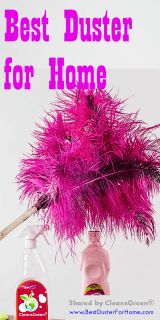
Common in the home are many items (such as furniture, baseboards, and our treasures) that call for dusting, especially when the windows are open to the outside. Knowing the vast variety of dust sources helps one to determine the best duster for home use.
Dust consists of many small particles, including pet fur and dander, plant pollen, dust mites, wind borne particulates, minerals from outdoor soil, insect excrement, allergens, hair, textile fibers, human skin cells, cobwebs, fine dirt, paper fibers, road dust, even burnt meteorite particles and volcanic ash. This and more all contributes to the ‘dust’ found in our homes.
House dust mites are prevalent everywhere where humans live. It is basically impossible to have an indoor environment without dust mites. Dust mites are microscopic arachnids whose primary food is dead human skin cells. They do not live on living people. Unfortunately, however, for those with asthma positive tests for dust mite allergies are extremely common.
As a result it is critical to identify the best duster for home use.
Duster Options for the Home
There are many options available for use, including electrostatic cloths and dusters, feathers, lambswool dusters, microfiber cloths and dusters, compressed air, vacuum cleaners, brushes, paper towels, rags and polish, and disposable “grab-it” cloths. Notes about some of these.
Feather dusters are comprised of feathers. Depending on their source will contribute to their how well they serve the purpose. The variety of feathers used includes goose down, chicken feathers, as well as gray, black, or floss ostrich feathers. While the black ostrich feathers are the most expensive, they are also the softest, flexible, and more “stringy” in nature thus most effective.
Electrostatic duster has thousands of thin synthetic filaments and works on the principle of building up a static charge on the plastic “fibers” to attract dust. While colorful and lightweight, it is hard to find a reliable source of static electricity since so many of us have replaced our tube television sets with the flat screen TV. Swiffer offers a disposable electrostatic cloth that is used by many, but can be expensive when they are constantly being replaced.
Lambswool dusters are made from the wool of a sheep. The wool naturally has a cuticle layer on the outer part of the wool fiber which is composed of hundreds of microscopic, overlapping scales. These scales create tiny pockets to trap and hold the dust particles. With the advent of the microfiber duster, it has been found that lambs wool does not have the dust collecting and retaining capabilities that microfiber does. As such many feel that microfiber has been replaced lambswool in the dusting world.
 Microfiber dusters (and cloths) have become a game changer in the cleaning industry since this has proven to be superior to other materials used for dusting. Microfiber is manufactured from a polyamide and polyester combination into ultra-tiny filaments where millions of them are joined to create a duster which will self-generate a charge opposite the dust so that it acts like a magnet that locks on to the dust. While it will retain the dust until released it can be cleaned easily and reused over and over.
Microfiber dusters (and cloths) have become a game changer in the cleaning industry since this has proven to be superior to other materials used for dusting. Microfiber is manufactured from a polyamide and polyester combination into ultra-tiny filaments where millions of them are joined to create a duster which will self-generate a charge opposite the dust so that it acts like a magnet that locks on to the dust. While it will retain the dust until released it can be cleaned easily and reused over and over.
Vacuum dusters are likely in every home, but rarely is it ever used. Unless you have leveraged the attachments that come with your vacuum cleaner, you likely have not used it either. One of the attachments that comes with your vacuum cleaner is a brush gadget that is installed on the end of the hose. It can be good to tackle the big jobs, but there is loads of preparation time and effort (i.e., labor) to get it set up. If not used, this attachment will continue to remain hidden away.
Compressed air in the “can of air” is pressurize gas and available from office supply stores. This is used for the specialized tasks of dislodging dust from computer keyboards and other electronics. As mentioned this is a highly specialized “tool”, single use, expensive, and is not effective for other dusting applications.
Best Duster for Home Recommendation
In summary microfiber (such as offered by CleansGreen® on Amazon) in the form of a duster with fluffy, filament rich head is the best duster for home for dusting.




